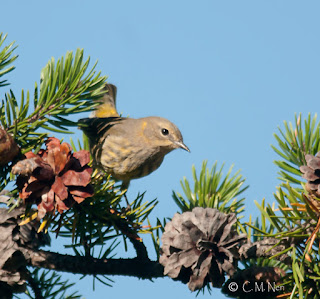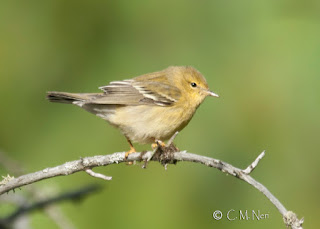Highlights: Hepatic Tanager (photo above),
Scissor-tailed Flycatcher,
Cave Swallow
Cave Swallow
&
Snowy Owls
This has been a good fall for uncommon species and vagrants at the Point, but there was no way Hepatic Tanager could have been on our radar. Michigan's first Hepatic Tanager, and one of very few records east of the Mississippi, was found on 10/20 at around noon and remained until 5:40. Unfortunately, like the Common Ground-Dove earlier this month it was also a one day wonder.
Another shot of the Hepatic Tanager
The latest vagrants were a Scissor-tailed Flycatcher that Eric Ripma had at from the waterbird count yesterday and a Cave Swallow at the harbor seen by Eric & Tim Baerwald this evening. Check the last two waterbird blog posts by Eric for a photo of the Scissor-tailed Flycatcher, which actually had no tail, and the Cave Swallow.http://wpbo.org/blog/5
As is typical this time of year, the weather has become more unsettled recently and the general bird activity around the Point has varied significantly from day to day. The mid-season migrants are giving way to the late season migrants. Warblers are essentially done for the season, but a few late stragglers were seen this week with single American Redstart, Northern Parula, Northern Waterthrush and Yellow-rumped Warbler observed. Sparrows have also really dropped off, but there are still a few White-crowned, American Tree and Fox Sparrows around, with American tree being the most common.The bulk of the Dark-eyed Junco has also passed through, but there are still a few double digit flocks around. Likewise, Golden-crowned and Ruby-crowned Kinglet numbers have dropped, but there are still always a few to be found. A few Winter Wrens were still around this week and Blue-gray Gnatcatchers have been seen the last few days.
With the mid-season migrants moving out we become hopeful for late season migrants and we are seeing some promising signs of a decent winter finch migration. Common Redpolls have been occurring in good numbers with hundreds migrating through on 10/23. We continue to have small numbers of Red Crossbills flying over and White-winged Crossbills have made a few more appearances recently. Evening Grosbeaks have picked up slightly with small flocks becoming a bit more regular and Eric saw the season's first Pine Grosbeak on 10/23. Bohemian Waxwings continue to be very sporadic, but hopefully they will pick up.
As is typical this time of year, the weather has become more unsettled recently and the general bird activity around the Point has varied significantly from day to day. The mid-season migrants are giving way to the late season migrants. Warblers are essentially done for the season, but a few late stragglers were seen this week with single American Redstart, Northern Parula, Northern Waterthrush and Yellow-rumped Warbler observed. Sparrows have also really dropped off, but there are still a few White-crowned, American Tree and Fox Sparrows around, with American tree being the most common.The bulk of the Dark-eyed Junco has also passed through, but there are still a few double digit flocks around. Likewise, Golden-crowned and Ruby-crowned Kinglet numbers have dropped, but there are still always a few to be found. A few Winter Wrens were still around this week and Blue-gray Gnatcatchers have been seen the last few days.
Ruby-crowned kinglet
The majority of the finches have been flyovers.
Pine Siskin (left) & Common Redpoll (right)
American Robin
Shorebirds are at the end of their migration, but here are an
American Golden-Plover (front left) and Black-bellied Plover.
Surprisingly, for the third year in a row Snowy Owls
seem to have started another big movement
into the region again this year.
A Puffin going by the Point
Chris Neri



















































